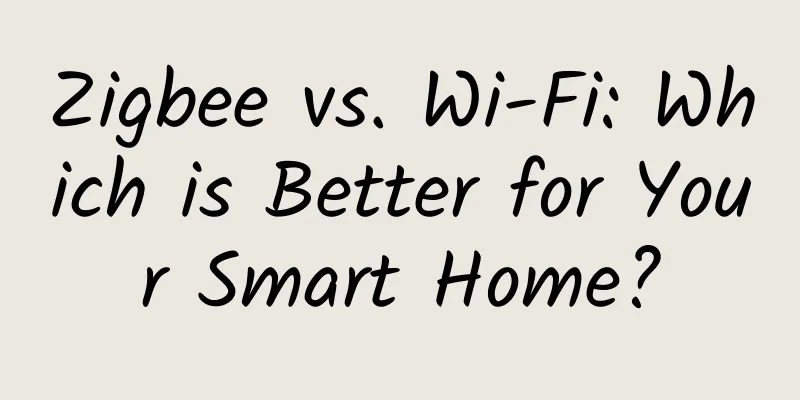Zigbee vs. Wi-Fi: Which is Better for Your Smart Home?

|
All smart home appliances rely on connectivity to a device, app, or hub. Wi-Fi is seen as a ubiquitous option for integrating a connected home. Of course, when you buy devices that are compatible with Alexa or Google Home, it’s best to pair them with secure Wi-Fi. You can easily use your existing home router without having to buy a separate smart hub to add devices.
But Wi-Fi has its limitations. Devices that run solely on Wi-Fi networks require frequent charging. Think laptops, smartphones, and even smart speakers. Plus, they don’t self-identify, and you have to manually enter your password for every new wireless device. If for some reason, the network connection slows down, it can turn your entire smart home experience into a nightmare. When it comes to wireless connectivity, Bluetooth has always been the second choice. However, in recent years, we have seen exponential growth in the use of another IoT protocol, Zigbee. Smart light manufacturer Philips Shue was an early supporter of the Zigbee open interoperable standard. Many smart home companies followed suit, and today Zigbee is almost as popular as Wi-Fi. Let's explore the relative pros and cons of using Zigbee or Wi-Fi. Understanding these differences is crucial because it can greatly influence your purchasing decision for a specific smart home product. Zigbee vs. Wireless Networking: Basic DifferencesThe Zigbee protocol was established in 2003 and is an open standard communication protocol based on IEEE802.15.4, which also manages other low-rate networks such as 6LoWPAN and Thread. The "bee" in the Zigbee name is inspired by the zigzag dance of bees when transmitting information over close range. Therefore, Zigbee is considered a low-power, low-bit-rate, short-range protocol in the 2.4ghz band for efficient communication between "mesh" devices. Zigbee has a top speed of 250 kbps, which is puny compared to Wi-Fi, and obviously, that's not the reason for its popularity. As shown in the figure, the Zigbee device object (ZDO) is located at a higher application layer than the physical (PHY) layer that runs the 2.4 GHz (and 915 Mhz) radio. This design fits the longer battery life characteristics of Zigbee devices. As a result, Zigbee devices consume orders of magnitude less power than Wi-Fi radio devices operating on a similar 2.4 GHz spectrum. Founded in 1997, Wi-Fi is a wireless networking protocol based on the IEEE 802.11 standard. It has a higher bandwidth, ranging from 32Mbps (802.11a/b/g) to 700 Mbps (802.11ax), also known as Wi-Fi 6. Originally used to connect computers and network devices in a local area network or wide area network, Wi-Fi has rapidly evolved to support communications for smartphones, smart speakers, smart TVs, and other smart consumer home appliances. Wi-Fi standards are maintained worldwide by the Wi-Fi Alliance to ensure compatibility and interoperability of Wi-Fi products. Unlike Zigbee, which uses a "coordinator" (Hub) device to join a Zigbee node, Wi-Fi is managed using a wireless router, Wi-Fi device, or portable hotspot. Also unlike Zigbee, Wi-Fi is designed to consume more battery power, and most commercial Wi-Fi-compatible devices have a Wi-Fi chip for communicating with a wireless access point (i.e., a Wi-Fi router). The technical differences between Wi-Fi and Zigbee products are much more detailed than this. This explains the main advantages and disadvantages of each technology relative to the other, and why each is suitable for different types of smart home applications. Zigbee vs. Wi-Fi: What are the advantages of Zigbee?(1) Forward and backward compatibility According to the Zigbee Alliance, a key highlight of Zigbee product certification is that they are designed to be compatible with older and future versions of Zigbee. The latest Zigbee 3.0 devices allow for backward compatibility, while older Zigbee devices can join the Zigbee 3.0 network based on the allowed security policies and through over-the-air updates. With Zigbee, if you have already deployed smart home devices in your network, you can be sure that they will be compatible with new Zigbee nodes. Wi-Fi doesn’t quite have that advantage, of course. While you can use Wi-Fi 6 alongside previous standards, there’s no forward compatibility for devices designed for earlier versions of Wi-Fi. (2) Fault tolerance Both Zigbee and Wi-Fi follow different network topologies. Zigbee is arranged around a mesh, where each node talks not only to a “coordinator” but also to other nodes, which increases fault tolerance. If one of the nodes is interfered with/damaged, it does not affect the rest of the network. There is a reason why industrial automation (IIoT) uses networks like Zigbee and Z-wave. The same benefits apply to smart homes. Wi-Fi networks typically use a "star" topology of routers and repeaters (although a Wi-Fi mesh structure is possible). If a Wi-Fi repeater in the network fails, the failure will be transmitted to all end node devices connected to that repeater. (3) Expanding coverage Zigbee allows each Zigbee node to act as a repeater, rather than manually adding repeaters like in a Wi-Fi network. As long as the ZDO is powered, it can act as a relay point to transmit signals to the end nodes. Therefore, the more Zigbee devices you buy, the wider the coverage (although you should be concerned about signal interruption caused by too many Zigbee nodes). (4) No need to enter password every time When using a Wi-Fi network, you will need to enter a password each time you add a new device. On the other hand, the Zigbee protocol supports a feature called "Device Discovery Service" because all Zigbee endpoints have a unique hexadecimal device ID. Client nodes in the network will be automatically discovered and connected to, eliminating the need to manually enter a password. (5) Reduce reliance on the cloud Zigbee end node devices are less dependent on cloud updates than Wi-Fi compatible devices. Although they do provide an over-the-air (OTA) update service, all Zigbee devices operate on their own mesh. In this way, they are vendor-agnostic. Therefore, if a device manufacturer stops supporting one or more features, it will not affect the field operation of existing deployments. (6) Low power consumption devices As mentioned above, Zigbee devices are designed to operate in low-power modes. This allows for more standby time and more continuous operation. The longer battery life comes at the expense of bit rate, and with a top speed of 250 bits/second, you can only use Zigbee for home automation. (7) Supported device types Zigbee is becoming a popular choice for HVAC control, lighting management, energy management, lighting monitoring, environmental monitoring, and commercial buildings. Some of the applications where Zigbee is commonly used include wireless and multi-function gateways, smart switches, dimmers, LED bulbs (such as Philip Hue lights), and other multi-purpose components. Where Wi-Fi Outperforms Zigbee(1) Cost It is well known that Zigbee smart devices are more expensive than Wi-Fi devices designed for the same purpose. This is because Wi-Fi devices have been on the market for a longer time. Also, for a given application, more device manufacturers may support Wi-Fi devices instead of Zigbee. This may limit your choices. However, the cost of Zigbee is reduced because you do not need to purchase a repeater separately. Each Zigbee device acts as an extended repeater. (2) Scope The challenge with most Zigbee devices is that they work better at short distances due to the physical properties of shortwaves. In contrast, long-range Wi-Fi can support distances of up to 100 meters. This means they are less susceptible to signal interference than Zigbee devices. Zigbee signals are weak anyway, and if there are too many Zigbee devices in a short distance, this can increase distortion and signal degradation. Modern Wi-Fi networks have overcome this obstacle by improving the quality of service, making them less susceptible to signal issues. (3) Equipment Integration It is easier to integrate Wi-Fi connectivity on IoT devices than Zigbee. Wi-Fi chips are assembled on almost all IoT boards and help connect to any wireless access point. (4) Security Wi-Fi is more secure than Zigbee. Since Zigbee is an open standard technology, compatibility between Zigbee devices from different manufacturers is better than Wi-Fi. On the other hand, all Zigbee devices speak the same universal language, so applications from different vendors are compatible with each other, which brings greater security risks. (5) Consumer IoT Applications Wi-Fi offers higher bandwidth and is undoubtedly better suited for consumer IoT applications such as smart speakers, smart nightstands, and other daily activities. You can't even send an email using Zigbee, so it's not suitable for any consumer IoT application that might require constant user interaction. They are indeed better suited for smart home automation. Wi-Fi vs. Zigbee: Which is better for your smart home?In our comparison of Zigbee and Wi-Fi above, we explored the pros and cons of each. If you want more autonomy and freedom from vendor control, Zigbee has more support, but it's too early to declare Zigbee the winner of our competition. Both network protocols have their standards for acceptable smart home use. If you're just starting to build a smart home, you're better off using Wi-Fi compatible devices that work with Alexa, Google Home, and other speakers. However, if you want to make some changes to your home with smart lights, curtains, switches, thermostats, and other building automation activities, having Zigbee-compatible devices and a smart home hub will better meet your needs. |
<<: 5G+ marks the next big shift for Asia’s industry
>>: What is the difference between a free SSL certificate and a paid one?
Recommend
Summary of Operation and Maintenance Experienced Drivers: 150 Commonly Used Commands
When it comes to operation and maintenance, every...
IDC: Global Enterprise WLAN Market Shows Moderate Decline in First Quarter of 2020
According to the results of IDC's global quar...
Bryan to launch fiber optic internet service
The city of Bryan, Texas, recently announced that...
TMThosting: Seattle high-security VPS with 20% off for monthly payment, 30% off for annual payment, China Unicom CUVIP line, Alipay support
It has been a while since I shared information ab...
The role of 5G in realizing the next generation of smart cities
5G can improve the quality and performance of urb...
iWebFusion dedicated server special promotion starting from $45/month, 5 data centers including Los Angeles are available
iWebFusion (iWFHosting) is still selling Clearanc...
BuyVM: AMD Ryzen high-performance VPS with a monthly payment of $3.5, 1Gbps unlimited traffic, multiple computer rooms available
BuyVM is a foreign VPS hosting provider founded i...
RAKsmart: San Jose dedicated server limited flash sale starting at $30/month, optional premium network or CN2 line
RAKsmart is a foreign hosting company operated by...
It is necessary to draw a clear line between the capital push and capital speculation behind blockchain
In recent days, the most eye-catching and frequen...
Ministry of Industry and Information Technology: my country's 5G mobile terminal connections reached 365 million, accounting for more than 80% of the world
On August 3, at the 2021 Global Digital Economy C...
What is the difference between wireless repeater and Mesh? This article will teach you how to use your home network well
At present, people's lives are becoming riche...
How to break the 100-meter transmission distance limit?
Local Area Networks (LANs) have historically been...
My girlfriend suddenly asked me what DNS is...
[[357457]] This article is reprinted from the WeC...
ColoCrossing: $10/year-1GB/20G SSD/1Gbps unlimited traffic/Los Angeles & New York data centers
ColoCrossing also started selling VPS, which is w...
Detailed explanation of five Docker container network modes
Docker networking sets up how containers communic...









